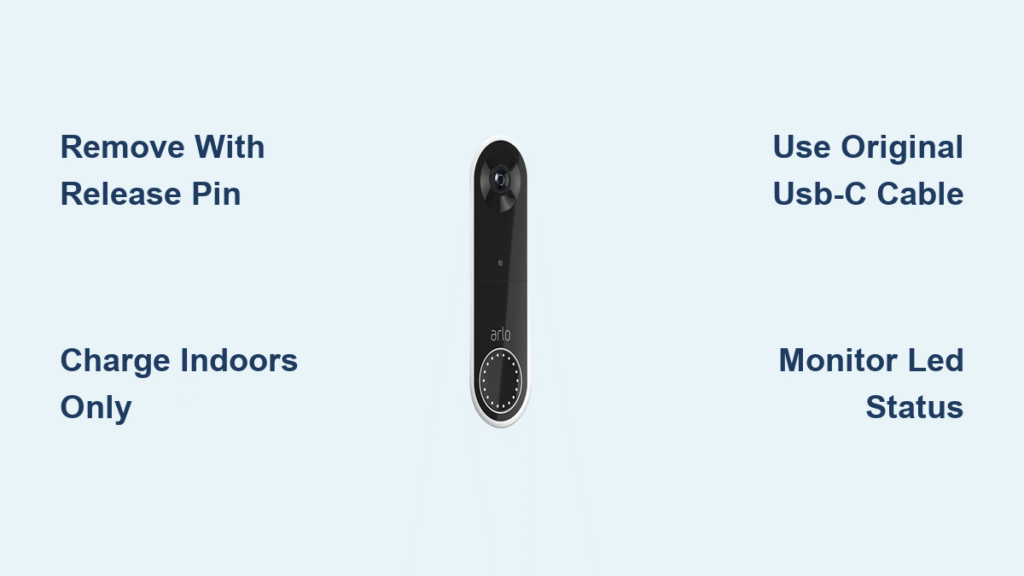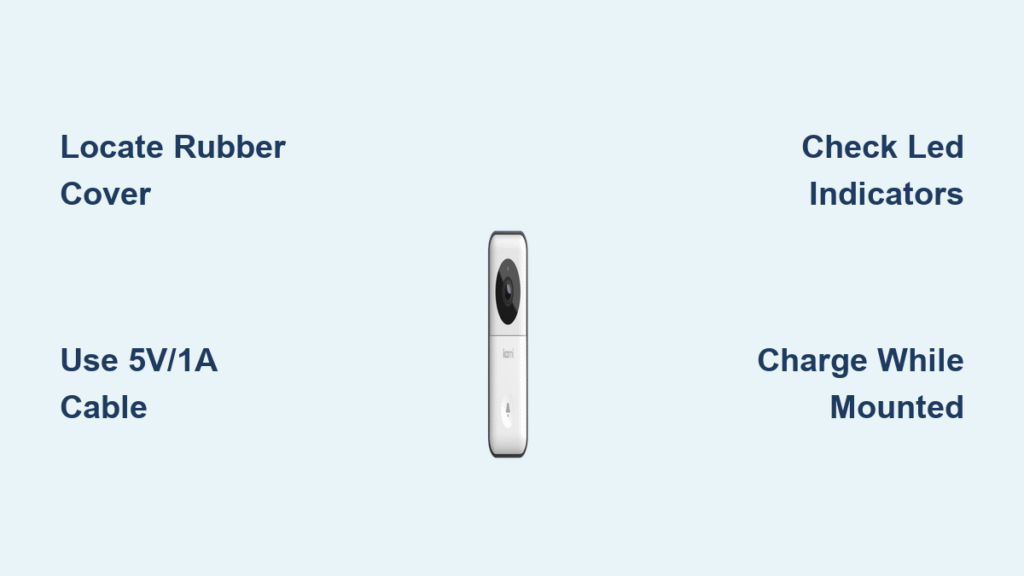Your package notification pings just as your Nest Doorbell camera goes dark—again. Without warning, your home security blind spot grows while you scramble to figure out how to charge Nest doorbell camera units properly. Unlike wired doorbells, the Battery model’s power limitations catch many homeowners off guard when critical deliveries or visitors arrive. This isn’t just an inconvenience; it’s a security gap.
Most users don’t realize their Nest Doorbell (Battery) requires manual charging every 2-6 months, depending on usage. When that low-battery alert finally appears, panic sets in: Will I miss the repair person? Can I charge it without tools? The good news? Restoring full power takes under 10 minutes with the right approach. This guide delivers the exact steps to charge your doorbell safely, troubleshoot failed attempts, and prevent future blackouts—all verified against official Nest specifications.
Remove Nest Doorbell From Mount Without Damage
Locate Your Release Tool or Screwdriver Alternative
Your Nest Doorbell (Battery) ships with a specialized metal release key designed to disengage the mounting mechanism safely. If misplaced, grab a standard flathead screwdriver with a tip under 3mm wide—thinner than a dime. Never use pliers, knives, or thick screwdrivers, as these can crack the housing or strip the release hole. Position yourself directly facing the doorbell to avoid awkward angles that might damage the mounting plate.
Execute the Correct Removal Technique
Insert your tool vertically into the small hole at the top center of the doorbell. Apply firm, steady pressure inward (toward the wall) until you hear a distinct click. This releases the internal latch. Immediately pull the unit straight upward—never twist or yank sideways—to slide it off the mounting plate’s hooks. If resistance exceeds gentle pressure, reposition your tool; forcing it risks breaking the retention clips. The entire removal should take 15 seconds.
Connect Charging Cable Using Verified Methods

Use the Included USB-C Cable Properly
Plug the USB-C end firmly into the port on the doorbell’s bottom edge until it clicks. The other end connects to any standard USB power source:
– A 5V/1A wall adapter (included in some kits)
– A computer USB port
– A power bank for on-the-go charging
Critical note: Charging only works when the doorbell is detached from the mounting plate. Attempting to charge while mounted—even with bell wires connected—will fail, as confirmed by Nest’s specifications.
Third-Party Charging Solutions That Actually Work
While Nest recommends their branded cable, quality USB-C cables meeting USB-IF certification work reliably. Avoid ultra-cheap cables with loose connectors, as intermittent contact causes charging failures. For permanent setups, continuous charging adapters (like the Nest Doorbell Wired Power Adapter) bypass battery dependence but require professional installation. Never use fast-charging adapters above 5V—they won’t speed up charging and may degrade battery health over time.
Monitor Charging Status With Visual Cues

Decode the LED Indicator Lights
Your doorbell’s ring light provides real-time charging feedback:
– Solid blue: Charging normally (90% of cases)
– Pulsing blue: Critically low battery; allow 15+ minutes before full functionality returns
– Solid green: 100% charged and ready for reinstallation
Pro tip: If lights remain off after 5 minutes, check cable connections—debris in the port often blocks contact. Use a dry cotton swab (not compressed air) to gently clear dust.
Estimate Realistic Charging Timelines
A completely drained battery typically requires 5-6 hours for full charging using a standard 5V/1A adapter. However, even 30 minutes of charging delivers enough power for 24-48 hours of operation—ideal for urgent situations. For accuracy, monitor the battery percentage in your Nest app (Settings > Device Information). Charging slows below 32°F (0°C) or above 95°F (35°C), so bring the unit indoors in extreme weather.
Reinstall Doorbell Securely After Charging
Achieve Perfect Mounting Alignment
Hold the doorbell at a 15-degree upward angle. Hook the bottom tabs into the mounting plate first, then press the top section firmly downward until it clicks into place. The unit should sit flush against your wall with no visible gaps or wobbling. If it feels loose, remove and retry—forcing it risks misalignment that strains internal components.
Validate Full Functionality Immediately
Test both hardware and app integration before walking away:
1. Press the physical doorbell button to confirm chime activation
2. Open the Nest app to verify live video feed
3. Check battery status shows 100%
If video fails but the button works, reboot the doorbell via the app (Settings > Device Settings > Reboot). Persistent issues after proper charging indicate deeper problems requiring reset.
Prevent Unexpected Battery Failures Proactively
Adjust Power-Saving Settings in Nest App
Reduce unnecessary drain with these tweaks:
– Lower motion sensitivity to “Medium” for areas with frequent false triggers (e.g., street traffic)
– Create activity zones focusing only on your porch/steps—not the entire street view
– Disable “Familiar Face Alerts” if rarely used
These changes can extend battery life by 30-50% based on user reports in Nest’s community forums.
Implement Smart Charging Schedules
Don’t wait for low-battery alerts. Establish a routine:
– Charge monthly during quiet periods (e.g., Sunday mornings)
– Set calendar reminders every 6 weeks for high-traffic homes
– Keep your release tool stored with the charging cable in a labeled container near your door
This prevents coverage gaps during critical times like holiday deliveries or vacations.
Troubleshoot Charging Failures Step-by-Step

Doorbell Shows No Charging Response
Follow this diagnostic sequence:
1. Swap cables and power sources (test with a known-working device like a phone)
2. Clean the charging port with a dry toothpick (no liquids!)
3. Try charging indoors at room temperature for 10 minutes
If still unresponsive, perform a factory reset: Hold the doorbell’s setup button for 10 seconds until the ring light flashes rapidly. Reconnect via the Nest app before recharging.
Charging Stalls at 80% or Takes Excessively Long
This usually indicates environmental factors:
– Temperature issues: Move charging indoors if outdoors below 32°F or above 95°F
– Faulty power source: Use only adapters rated 5V/1A (higher amps won’t help)
– Aging battery: After 2+ years, batteries hold less charge—consider replacement
Never leave the doorbell charging unattended overnight; 8 hours is the maximum safe duration per Nest’s guidelines.
A fully charged Nest Doorbell (Battery) provides reliable security for 2-6 months, but only if you master its charging quirks. By removing the unit correctly with your release tool, using verified USB-C connections, and implementing power-saving settings, you’ll eliminate frustrating blackouts. Critical takeaway: Always store your release tool with the charging cable—this 10-second habit prevents 90% of emergency charging delays. For persistent issues after following these steps, consult Nest’s official support for battery replacement options, as degraded cells can’t be repaired. Keep your home secure without the panic: charge proactively, not reactively.





